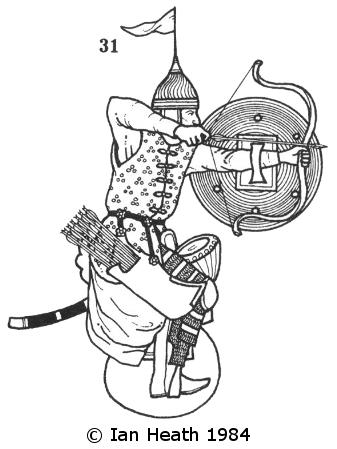
Try Amazon Audible Plus
PERSIAN CAVALRYMAN, LATE-15th CENTURY
An extract from Armies of the Middle Ages, Volume 2by Ian Heath


|
31. PERSIAN CAVALRYMAN, LATE-15th CENTURY
Though a White Sheep Turk, from the province of Herat, this figure could equally well be a Timurid. He wears a gilt-studded red brigandine over a yellow tunic, plus tan leather belt and high-heeled boots (recorded by Barbaro to have been worn by the Persians and Georgians alike; in fact Georgians would have been indistinguishable from Persians). His quiver is black, saddle-flap dark blue, kalkan shield green with iron boss and gilt studs, and helmet pennon yellow. Such helmet pennons first began to appear in Persia in the first half of the 15th century. Probably of Chinese origin, they seem to have been introduced into both Russia and Persia via the Timurids. Note that the helmet itself is also different from that of the last figure, rectangular iron ear-pieces having now replaced the disc-flaps.
This figure is probably an officer since, although the other figures around him ride unarmoured horses, he rides a horse in a scale bard. In addition he has at his saddle-bow a small, red-rimmed white drum of a type called a kovarga, seemingly carried only by officers. Such drums were in widespread use throughout Persia, Turkey, Syria and Egypt. Bertrandon de la Brocquière records how in Syria ‘the men of fortune carry with them, when they ride, a small drum, which they use in battle, or in skirmishes, to rally their men. It is fastened to the pommel of their saddles and they beat on it with a piece of flat leather.’ Similarly, describing Taj-ad-Din Ibrahim, amir of Karaman, he says he ‘had a tabolcan (ie, tablkhan) at the pommel of his saddle, according to the custom of the country’, and describing Ottoman tactics he says that each horseman (actually only the officers) ‘has also on the pommel of his saddle a tabolcan. When the chief, or any of his officers, perceives the enemy who pursues to be in disorder, he gives 3 strokes on this instrument; the others, on hearing it, do the same, and they are instantly formed round their chief’. Arnold von Harff shows a drum being carried in his picture of a typical Mamluk, and the Mamluks’ use of such drums is confirmed by Gilbert de Lannoy’s account of 1422, which reports that they served in place of trumpets ‘to call them together. Besides, when they see their enemies drawn up in order of battle, they sound them all at once to terrify their horses.’ He records that Mamluks, Syrians and Turcomans alike carried such drums. Similar drums were apparently also used in parts of Eastern Europe, eg, by the Hussites (see figure 126) and Poles, and probably by the Tartars too.